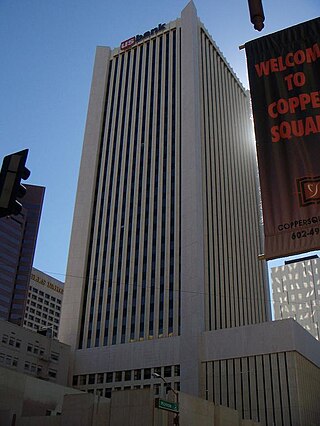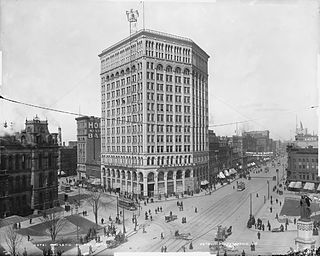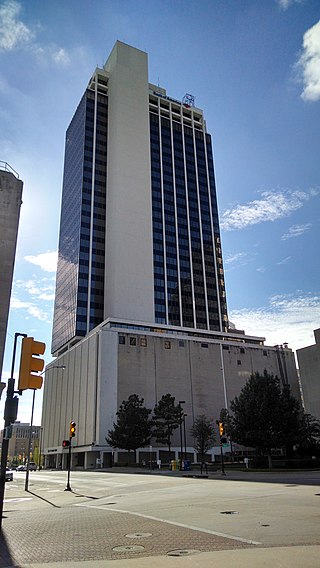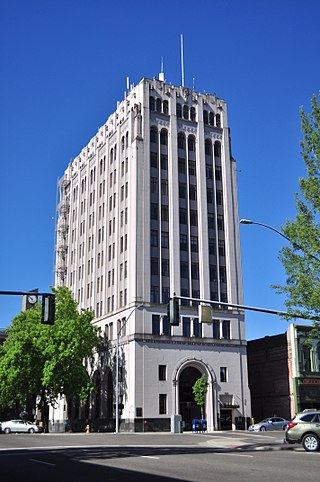
Tulsa is the second-most-populous city in the state of Oklahoma, after Oklahoma City, and is the 48th-most-populous city in the United States. The population was 413,066 as of the 2020 census. It is the principal municipality of the Tulsa metropolitan area, a region with 1,034,123 residents. The city serves as the county seat of Tulsa County, the most densely populated county in Oklahoma, with urban development extending into Osage, Rogers and Wagoner counties.

CityPlex Towers is a complex of three high-rise office towers located at 81st Street and Lewis Avenue in Tulsa, Oklahoma. The complex was originally constructed by Oral Roberts University as City of Faith Medical and Research Center and meant to be a major charismatic Christian hospital. The complex is now home to 3 individual hospitals with over 20 surgery suites as well as 100+ additional tenants.

The architecture of Houston includes a wide variety of award-winning and historic examples located in various areas of the city of Houston, Texas. From early in its history to current times, the city inspired innovative and challenging building design and construction, as it quickly grew into an internationally recognized commercial and industrial hub of Texas and the United States.

The US Bank Center is a high-rise office building located in Phoenix, Arizona. It is the second tallest building in the state of Arizona. Built in 1976, it is 407 feet (124 m) tall.

The 320 South Boston Building is a 22-story high-rise building located in downtown Tulsa, Oklahoma. It was originally constructed at the corner of Third Street and Boston Avenue as a ten-story headquarters building for the Exchange National Bank of Tulsa, Oklahoma in 1917, and expanded to its present dimensions in 1929. The addition brought the building's height to 400 feet (122 m), making it the tallest building in Oklahoma. It lost this distinction in 1931, but remained the tallest building in Tulsa until Fourth National Bank was completed in 1967. It is now included in the Oil Capital Historic District.

The Majestic Building was a high-rise building located at 1001 Woodward Avenue in Downtown Detroit, Michigan. The building was constructed in 1896 for the Mabley and Company department store chain and was the city's second skyscraper, following the completion of the Hammond Building. It contained 14 stories and stood at 68 m (223 ft) in height. This building was designed in the Beaux-Arts style by Daniel H. Burnham & Company, and faced with terra cotta. The final construction cost of the building was $1,000,000. This was Detroit's tallest building, from its completion in 1896 until 1909, when it was overtaken by the Ford Building. Unfortunately, C. R. Mabley died before the building's completion and new owners used it solely as an office block. It was purportedly renamed the Majestic building to conform with the letter "M" carved in numerous places in its façade.

The Bank of America Center is a commercial high-rise building in Tulsa, Oklahoma. The building rises 412 feet in downtown Tulsa. and contains 288,776 square feet (26,828.2 m2) of space. It has 32 floors, and was completed in 1967 as the Fourth National Bank of Tulsa. It is located on the corner of Sixth Street and Boulder Avenue, the site of the former Tulsa County court house. The Bank of America Center currently stands as the 5th-tallest building in the city, and the 9th-tallest building in the state of Oklahoma. The architectural firm who designed the building was Kelley & Marshall of Tulsa. The Bank of America Center contains offices of the Charlotte-based Bank of America Corporation. It currently stands as the 2nd-tallest international style skyscraper in the city, behind the BOK Tower. It also houses the offices of several petroleum companies and the Oklahoma State Attorney General's office.

The 110 West 7th Building is a commercial high-rise building in Tulsa, Oklahoma. The building rises 388 feet (118 m), making it the 7th-tallest building in the city, and the 14th-tallest building in the U.S. state of Oklahoma. It currently stands as the 3rd-tallest International Style skyscraper in the city, behind the BOK Tower and the Bank of America Center. The building, with its black and white grid exterior floodlighted at night, is a Tulsa landmark.

The University Club Tower is a residential high-rise building in Tulsa, Oklahoma. The building rises 377 feet. It contains 32 floors, and was completed in 1966. The University Club Tower currently stands as the 8th-tallest building in the city, and the 15th-tallest building in the state of Oklahoma. It also currently stands as the tallest all-residential building in Tulsa and Oklahoma. The circular building, marked by unusual floorplans surrounding its central core, was the first major building in the United States to be designed using a computer.
Liberty Tower, officially Liberty Tower Condominiums, is a commercial/residential high-rise building complex in Tulsa, Oklahoma. The building rises 254 feet. It contains 24 floors, and was completed in 1965. Liberty Tower currently stands as the 11th-tallest building in the city, and the 25th-tallest building in the state of Oklahoma. It also currently stands as the 2nd-tallest commercial-residential building in Tulsa, after the University Club Tower, and the 3rd-tallest in the state. Liberty Tower is the 5th-tallest international style skyscraper in the city, behind the Cityplex Tower, the First Place Tower, the University Club Tower and Cityplex West Tower.

Boulder Towers is a large commercial building complex in Tulsa, Oklahoma. The complex consists of two twin high-rise buildings, Boulder Towers East Tower and Boulder Towers West Tower, which both rise 253 feet. Each building contains 15 floors. The complex was originally constructed in 1960, consisting of only the West Tower; the East Tower was constructed in 1980. The Boulder Towers currently stand as the tallest twin towers in Tulsa and the state of Oklahoma. In addition, as of October, 2018, they are tied as the 18th-tallest buildings in Tulsa. The Boulder Towers are the 6th-tallest modern style skyscrapers in the city, behind the Cityplex Tower, the First Place Tower, the University Club Tower, Cityplex West Tower and the Liberty Towers complex.

The First National Bank Building is a commercial high-rise building in Tulsa, Oklahoma. The building rises 250 feet in downtown Tulsa. It contains 20 floors, and was completed in 1950. The First National Bank Building currently stands as the 15th-tallest building in the city, and the 30th-tallest building in the state of Oklahoma. The architectural firm who designed the building was Carson & Lundin. It currently stands as the 7th-tallest modern style skyscraper in the city, behind the Cityplex Tower, the First Place Tower, the University Club Tower, Cityplex West Tower, the Liberty Towers complex and the Boulder Towers complex. The First National Bank Building notably stands as the first modern style high-rise to be built in Tulsa, and was the only skyscraper to be constructed in the city between 1928, when the 320 South Boston Building was completed, and 1960, when Boulder Towers West Tower was constructed.
The Westin at Tulsa Garden Square is a high-rise building proposed for construction in Tulsa, Oklahoma. The building was submitted to the Tulsa Development Authority on April 20, 2006, and is planned to be constructed adjacent to the recently completed BOK Center in downtown Tulsa. The proposed structure covered the city block bounded by Second to Third Streets and Cheyenne to Denver Avenues. The proposal also requested demolition of an apartment building and a small office building then on the property, and relocation of the Tulsa Transit Denver Avenue bus terminal. If constructed, the Westin at Tulsa Garden Square would contain a 246-room Westin hotel, as well as 72 residential condominiums. The 15-story building would likely stand as the 2nd-tallest hotel in Tulsa upon completion, behind the Mayo Hotel.

The Capitol Center is a high-rise office building in downtown Salem, Oregon, United States. Finished in 1927, it was originally known as the First National Bank Building and owned by Salem businessman Thomas A. Livesley. The eleven story building was designed by architect Leigh L. Dougan and is the tallest office building in Salem. Located at State and Liberty streets it is part of Salem's downtown historic district and was added to the National Register of Historic Places in 1986 as the Old First National Bank Building.

The Oil Capital Historic District (OCHD) is an area in downtown Tulsa, Oklahoma that commemorates the success of the oil business in Tulsa during the early 20th century. During this period, Tulsa was widely known as "The Oil Capital of the World." The area is bounded by 3rd Street on the north and 7th Street on the south, Cincinnati Avenue on the east and Cheyenne Avenue on the west.














